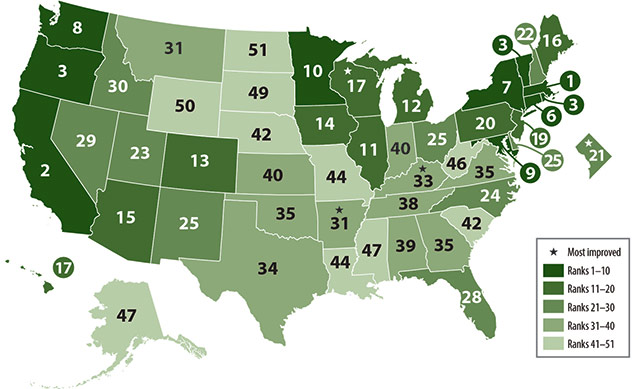
NEWS RELEASE
For Immediate Release
Media Contact: Patrick Kiker
pkiker@aceee.org, 202.507.4043
Massachusetts Tops California as Most Energy-Efficient State, while Arkansas, D.C., Kentucky, and Wisconsin are Most Improved
Top 10 States are MA, CA, RI, OR, VT, CT, NY, WA, MD, and MN; 5 States Most in Need of Improvement are ND, WY, SD, MS, and AK
WASHINGTON, D.C. (October 22, 2014):Governors and lawmakers in state capitals across the nation continue to take major steps to lower energy costs, reduce pollution, and save consumers money by increasing their states' energy efficiency, according to the findings of the 8th edition of the State Energy Efficiency Scorecard released today by the American Council for an Energy-Efficient Economy (ACEEE).
Available online at http://aceee.org/state-policy/scorecard, the report found that in 2014 Massachusetts (#1) continues to edge out California (#2) as the most energy-efficient state in the nation for the fourth year in a row. Following these states in the top 10 are: Rhode Island (marking the state's first time in top five), Oregon, and Vermont (all tied for #3); Connecticut (#6); New York (#7); Washington (#8); Maryland (#9); and Minnesota (#10).
Other key State Energy Efficiency Scorecard findings include the following:
- Arkansas, the District of Columbia, Kentucky, and Wisconsin are the four most improved energy-efficiency states for 2014. Arkansas pushed forward with strong utility programs. The state's budgets for electric efficiency programs increased 30% between 2012 and 2013, while electricity savings more than tripled. The District of Columbia and Wisconsin also saw upticks in energy savings. Kentucky took notable steps to adopt a more efficient commercial building energy code.
- From dead last and up, the five states most in need of improvement on energy efficiency in 2014 are North Dakota, Wyoming, South Dakota, Mississippi, and Alaska.
- Overall, states are ramping up their commitments to energy efficiency. Savings from electricity efficiency programs in 2013 totaled approximately 24.4 million megawatt-hours (MWh),a 7 percent increase over 2011 savings reported last year by ACEEE. Gas savings for 2013 were reported at 276 million therms (MMTherms), a 19 percent increase over the 2011 savings reported in the previous ACEEE State Scorecard.
- A total of 23 states fell in the energy efficiency rankings in 2014. Indiana dropped the furthest, by 13 spots, due inpart to state legislators' decision to eliminate the state's long-term energy savings goals. Legislators in Ohio made a similar decision to freeze and substantially weaken the state's energy efficiency resource standard (EERS), contributing to the state's fall of 7 spots down the rankings. Despite these policy setbacks, utilities in both states have indicated they will continue running efficiency programs, albeit at levels below what would have been required by the standards.
- ACEEE found that states that enforce and adequately fund an EERS drive investments in utility-sector energy efficiency programs. The states with the most aggressive savings targets include Arizona,Massachusetts,and Rhode Island.
Maggie Molina, Director of ACEEE's Utilities, State, and Local Policy program, said: "More and more governors and state lawmakers understand that they have a choice: Do nothing as costly energy is wasted or take action by creating incentives to waste less energy. Smart energy efficiency choices maintain the same comfort, convenience, and quality of life that consumers want and expect. Energy efficiency is also good for business. State action on energy efficiency improves bottom lines, drives investment across all sectors of the economy, creates jobs, and offsets the environmental harms created by the energy production system."
Massachusetts Governor Deval Patrick said: "We have treated efficiency as our first fuel because saving energy, managing costs, and reducing environmental impacts while building a stronger cleantech economy helps fulfill our responsibility to future generations to leave a stronger Commonwealth than we found."
JD Lowery, Director of the Arkansas Energy Office, a division of the Arkansas Economic Development Commission, said: "Much of Arkansas' improvement must be attributed to the ongoing leadership of our Arkansas Public Service Commissioners, our utility partners, and our citizens. Through innovative programs, both businesses and households in Arkansas have discovered the economic benefits of investing in energy efficiency. Energy efficiency is no longer this unknown thing. We're creating jobs while saving Arkansans money. Everybody wins."
Other key findings include the following:
- Total budgets for electricity efficiency programs in 2013 reached $6.3 billion. Adding that to natural gas program budgets of $1.4 billion, total efficiency program budgets were estimated to be more than$7.7 billion in 2013.
- The leading states in utility-sector energy efficiency programs and policies were Rhode Island, Massachusetts, and Vermont.With long records of success, all three continued to raise the bar on cost-effective programs and policies. Both Massachusetts and Rhode Island earned maximum points in this category.
- The leading state in building energy codes and compliance was California. Eleven states and the District of Columbia have officially adopted the latest standards for both residential and commercial buildings.
- California and New York led the way in energy-efficient transportation policies. California's requirements for reductions in greenhouse gas (GHG) emissions have led it to identify several strategies for smart growth,while New York is one of the few states in the nation to have a concrete vehicle-miles-traveled reduction target.
- Other states have also made recent progress in energy efficiency. Nevada scored additional points for its building codes and compliance measures. Delaware passed a significant energy efficiency bill in early July, laying the ground work for customer-funded energy efficiency programs. This policy shift did not result in an improved score this year, but it will likely garner additional points in future editions of the State Scorecard as programs are implemented and regulations are finalized.
- The U.S. territories of Puerto Rico, Guam, and the U.S. Virgin Islands have taken steps to improve energy efficiency in new construction by adopting building energy codes, but have generally not made investments in efficiency in other sectors. This is the first year these territories have been included in the State Scorecard.
ACEEE State Policy Research Analyst Annie Gilleo, lead author of the 2014 State Energy Efficiency Scorecard, said: "The State Scorecard provides an annual benchmark of the progress of state energy efficiency policies and programs. It encourages states to continue strengthening their efficiency commitments in order to promote economic growth, secure environmental benefits, and increase their communities' resilience in the face of the uncertain cost and supply of the energy resources on which they depend. The State Scorecard offers a toolkit that policymakers can use to increase energy savings in their state."
METHODOLOGY
The State Energy Efficiency Scorecard benchmarks states across six policy areas - utility policies and programs, transportation initiatives, building energy codes, combined heat and power development, state government-led initiatives, and state-level appliance standards. In total, states are scored on more than 30 individual metrics. Data is collected from publicly available sources and vetted by state energy offices and public utility commissions.
The American Council for an Energy-Efficient Economy acts as a catalyst to advance energy efficiency policies, programs, technologies, investments, and behaviors. For information about ACEEE and its programs, publications, and conferences, visit http://aceee.org.
###





